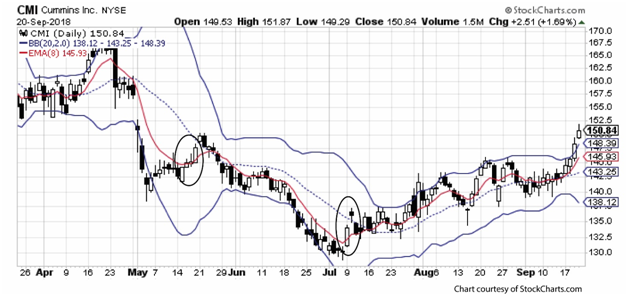
To review: Bollinger Bands has three averages. The middle band is a 20-period simple moving average. The upper band and lower band are the second and third parts. Each are two standard deviations away from the middle band. This is a visual summary of historical volatility. Price generally is not likely to trade above the upper band or below the lower band for very long. When price does move outside of these ranges, it retreats back into range very quickly. So BB is like a “probability matrix” for timing entry and exit.
The T-line is an 8-day exponential moving average of price that yields surprisingly reliable signals for changes in price direction. The rule is that when price is above the t-line, it remains bullish until it crosses below and closes for at least two sessions. This sets up a bearish reversal. When price is below the t-line, the prevailing bearish trend continues until price crosses above and closes above for at least two consecutive sessions.
Taken apart, BB and the t-line are powerful on their own. However, when used in combination, you set up a very powerful dynamic trading range, making it easy to spot when a trend ends. As price advance, the BB upper band represents resistance and the t-line is support. When prices are moving down, the t-line is resistance and the BB lower band is support.
The chart for Cummins (CMI) shows the reversal signals this combination highlights.

The combined signal sets up the narrow channel based on whether price trend is bullish or bearish. In a bullish trend, the upper Bollinger Band is rising resistance and the t-line (red on the chart) is rising support. The bullish trend continues until price crosses below the t-line and closes there for two consecutive sessions.
In a bearish trend, the t-line represents declining resistance and the lower Bollinger Band is declining support. The bearish trend continues until price crosses above the t-line and closes above for two consecutive sessions.
The CMI chart shows how this works. In May, price had been declining down to as low as $140 per share. But at mid-month, price crossed above the t-line (the red line), demonstrating that the downtrend, for the moment at least, was ending.
At the beginning of July, a further decline ended when price again moved across the t-line and marked the beginning of a gradual advance.
The combination of Bollinger Bands and t-line is so reliable that it can be used effectively in two ways. First, it distinguishes between retracement (not moving across the t-line) and reversal. Second, actual crossover is the signal point for leaving a current trade and taking profits, or for entering a new trend based on the newly revised price direction.
This solves the most disturbing aspect of short-term options trading. When do you enter and exit a trade? Even with the lack of clear reversal signals, the combined use of BB and the t-line is a powerful and reliable system to improve timing.
Michael C. Thomsett is a widely published author with over 80 business and investing books, including the best-selling Getting Started in Options, coming out in its 10th edition later this year. He also wrote the recently released The Mathematics of Options. Thomsett is a frequent speaker at trade shows and blogs on his website at Thomsett Guide as well as on Seeking Alpha, LinkedIn, Twitter and Facebook.






There are no comments to display.
Create an account or sign in to comment
You need to be a member in order to leave a comment
Create an account
Sign up for a new account. It's easy and free!
Register a new account
Sign in
Already have an account? Sign in here.
Sign In Now